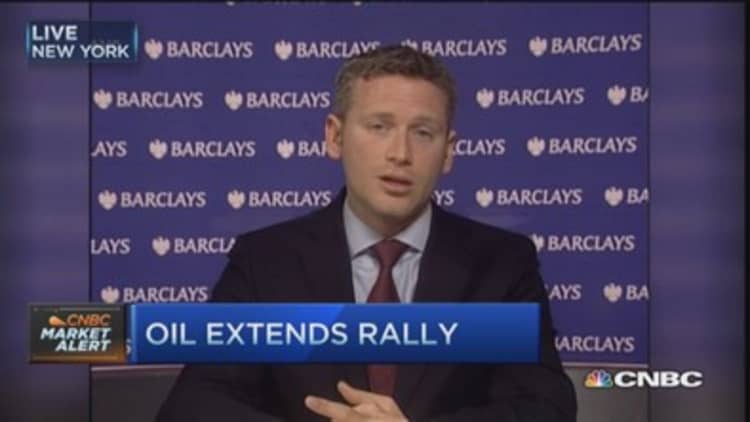
Benchmark West Texas Intermediate oil ended higher on Monday after data showing a partial draw in stockpiles at the delivery point for U.S. crude helped steady a market weighed earlier by near record highs in Saudi production.
After a volatile trading session, U.S. crude for May settled up 64 cents, or 1.2 percent, at $56.38 a barrel. Brent crude gave up earlier gains to trade down 13 cents to $63 a barrel. I hit a intraday peak of $64.34.
Tensions in the Middle East and a drop last week in the number of rigs drilling for oil in the United States also put a floor beneath U.K. North Sea Brent and U.S. crude futures, traders said.
Read MoreFor crude oil, this looks like 2009 all over again
"The market was bouncing around looking for news to latch on to, and the draw numbers for U.S. crude certainly helped," said Phil Flynn, analyst at the Price Futures Group in Chicago.
Oil services firm Genscape reported a draw of more 900,000 barrels at the Cushing, Oklahoma delivery point for U.S. crude between Tuesday and Friday last week, market sources who saw the data said. For the week to Friday, Genscape reported a build of about 350,000 barrels, they said.



Speculation has been rife that the rapidly climbing U.S. crude supplies would soon cause storage tanks in Cushing to top, leaving little or no room for more barrels. The draw reported by Genscape eased at least some of that anxiety, traders said.
U.S. oil drilling rigs fell for a record 19th straight week to the lowest since 2010, data from oil services firm Baker Hughes showed on Friday. That has helped lift prices from six-year lows reached in January.
Since the beginning of April, oil prices have risen around 17 percent, pushed up by reports of a possible dip in U.S. output, but Morgan Stanley warned that Saudi production could be more important than developments in the United States.
"We worry about the market's fixation on the U.S. ... OPEC production may be more important as production increased 1 million barrels per day month-on-month in March. Saudi Arabia alone added the equivalent of half of Bakken (the largest U.S. shale oilfield) production in a matter of months—far beyond any U.S. slowdown," the bank said in a note.
Read MorePrepare for a 'messy' year-end for oil: Citi's Kleinman
Production in the world's biggest crude exporter would stay near record peaks around 10 million bpd in April, Saudi Arabia's oil minister, Ali al-Naimi, told Reuters on Monday in Seoul, where he was due to attend a board meeting of the state oil firm Saudi Aramco.
"I have said many times we will always be happy to supply to our customers with what they want. Now they want 10 million," he said.
Also on Monday, Saudi Interior Ministry spokesman Mansour Turki said the government had put security forces on alert for a possible militant attack on a shopping mall or energy installation, adding support to oil prices.
Riyadh has been carrying out air strikes against Iran-allied Houthi rebels in neighboring Yemen since March 26 in a conflict in which nine members of its security forces have been killed by cross-border fire.

